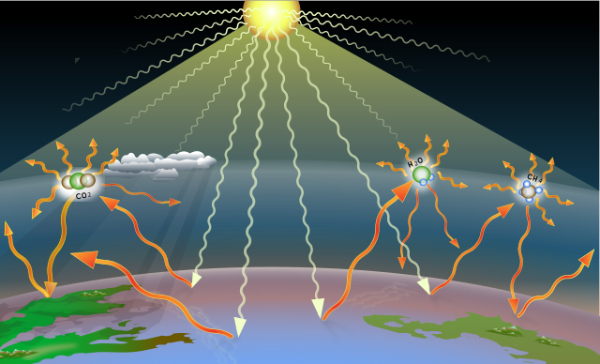The Intergovernmental Panel on Climate Change replaced the Advisory Group on Greenhouse Gases. According to the latter organization, 1 C was the Rubicon we could not cross.
That’s 1 C beyond the 1750 baseline, when the global-average temperature was about 13.5 C. The IPCC, on the other hand, quoted an economist in concluding 2 C beyond the 1750 baseline was the upper limit. Both numbers were designed to prevent self-reinforcing feedback loops, which are sometimes called feedback loops or tipping points. According to governments of the world, Earth passed 2 C above the 1750 baseline in October 2023.
From the Advisory Group on Greenhouse Gases in October 1985, the last year of its existence, comes this quote: “Beyond 1 degree C may elicit rapid, unpredictable and non-linear responses that could lead to extensive ecosystem damage.” Climate writer and speaker David Spratt said that self-reinforcing feedback loops were triggered at 0.5 C during a presentation delivered during October 2014 and titled Dangerous Climate Change: Myths & Realities.
The IPCC was designed to fail when it was created during the Ronald Reagan administration. Specifically, according to Princeton Professor Michael Oppenheimer, writing on the Environmental Defense Fund website on 1 November 2007: “… the US government saw the creation of the IPCC as a way to prevent the activism stimulated by my colleagues and me from controlling the policy agenda.”
Once a self-reinforcing feedback loop is triggered, the situation is no longer in the hands of humans. By definition, the situation is self-reinforcing. In other words, there is no known way to stop climate change from accelerating.
Some people have proposed various means by which we might be able to stop the unstoppable. These include various manipulations of the atmosphere, as well as manipulations of the surface of Earth. The stunning inability of humans to positively manipulate the Earth System in the past apparently is not sufficiently compelling to stop the implementation of additional, untested strategies.
Let’s take a quick look at the current situation. First, a quick tidbit about one of the lesser-known greenhouse gases, nitrous oxide. Nitrous oxide is one of 43 greenhouse gases listed in a peer-reviewed paper published on 31 May 2017. The paper was written by 25 scholars and published in Geoscientific Model Development, a publication of the European Geosciences Union. According to a preprint written by 58 scholars and published on 9 October 2023 in Earth System Science Data, 10 million metric tons of nitrous oxide were released into the atmosphere in 2020 alone. Nitrous oxide is about 300 times more powerful a greenhouse gas than carbon dioxide. There is no known way to remove nitrous oxide from the atmosphere, a gas that has increased 25% in the atmosphere since pre-industrial times.
Again, nitrous oxide is one of the lesser-known greenhouse gases, along with many others in the list of 43 greenhouse gases. Most people know about carbon dioxide. Some know about methane. Few know about nitrous oxide, hydrofluorocarbons, perfluorocarbons, sulfur hexafluoride, or nitrogen trifluoride. Almost nobody knows about the most abundant greenhouse gas, water vapor. I would bet there are fewer than a dozen people on Earth who could list all 43 greenhouse gases without some serious study or access to an online search engine. I am not among the dozen.
Earth is stunningly warm. According to a headline at the Guardian from 11 June 2024, ‘It’s unbearable’: in ever-hotter US cities, air conditioning is no longer enough. According to this article, air conditioners cannot keep up with contemporary conditions. According to a climate scientist quoted in the Guardian, keeping the temperature inside a home at 75 degrees Fahrenheit requires 30% more power when outdoor temperatures increase from 95 F to 98 F. In other words, keeping the indoor temperature at 24 C requires 30% more power when outdoor temperatures increase from 35 C to 36 and 2/3 C.
Among the many negative outcomes associated with a warming planet is a change in the pattern and intensity of events such as hurricanes and tornadoes. These phenomena are means of releasing energy from an increasingly overheated and therefore energetic planet. In addition to more and larger hurricanes and tornadoes, tornadoes are shifting east in the United States, thereby putting more people at risk.
You might be wondering what all this has to do with Coco Chanel. One of her famous expressions was about life and love: “There is a time for work, and a time for love. That leaves no other time.”
Author
"Dr. Guy McPherson is an internationally recognized speaker, award-winning scientist, and the world’s leading authority on abrupt climate change leading to near-term human extinction. He is professor emeritus at the University of Arizona, where he taught and conducted research for twenty years. His published works include 14 books and hundreds of scholarly articles. Dr. McPherson has been featured on TV and radio and in several documentary films. He is a blogger, cultural critic, and co-host of his own radio show “Nature Bats Last.” Dr. McPherson speaks to general audiences across the globe, and to scientists, students, educators, and not-for-profit and business leaders who seek their best available options when confronting Earth’s cataclysmic changes." source






